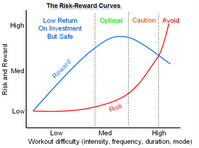More on Risk-Reward
 A few weeks ago I wrote here about risk and reward in training. It seems I run into this issue a lot when talking with age-group athletes any more. It is seldom an issue with pros who tend to be more conservative in their choice of workouts. Amateurs are much more willing to take risks by doing workouts that are ridiculously intense or long or, usually, both.
A few weeks ago I wrote here about risk and reward in training. It seems I run into this issue a lot when talking with age-group athletes any more. It is seldom an issue with pros who tend to be more conservative in their choice of workouts. Amateurs are much more willing to take risks by doing workouts that are ridiculously intense or long or, usually, both.
Every workout has a reward associated with it as well as a risk. Typically, workouts that are low risk are also low reward. And high risk workouts generally have a high reward associated with them. A good example of the latter is plyometrics. For runners, especially, plyometrics offers a high reward but this comes with a high amount of risk. Eccentric plyo is even riskier than concentric plyo and comes with a higher reward. Weight training with heavy loads is risky but also has the potential for high reward. And within heavy weight training squats have a higher risk-reward factor than leg press.
The same is true of the typical workouts in endurance sports such as swimming, cycling, running and cross-country skiing. Of these, the highest risk are highly intense intervals and force-overload workouts such as big gear hill work on a bike and resisted swim workouts. The risk usually has to do with injury but may also be more subtle by increasing the athlete's fatigue level so much that normal training is delayed for days. If this high fatigue is ignored, overtraining may soon be a result of training and cost the athlete weeks if not months of training. I've seen it happen. When it is most likely to happen is when the athlete is in great shape. When fitness is at a high point in the season there is a feeling of invincibility and a willingness to take more risk due to feeling of being "bullet proof."
When in great shape you are only one workout away from losing it all. Now is the time of year to be cautious with your training. Respect the risk associated with challenging workouts and decide if the risk is worth the reward. As a coach I almost always decide in favor of taking less risk.


2 Comments:
Gee, Joe, you coulda posted this article a few eeks ago before I chose to do a high-risk workout. Now I'm stuck with runner's knee and achilles tendonitis.
Let this be a stern warning to all you uninjured out there that what Joe is saying carries a lot of weight.
Like... ummm... me, after 2 weeks of injury lay-off. :-(
Gee, Joe, you coulda posted this article a few weeks ago before I chose to do some high-risk workouts. Now I'm stuck with runner's knee and achilles tendonitis.
Let this be a stern warning to all you uninjured out there that what Joe is saying carries a lot of weight.
Like... ummm... me, after 2 weeks of injury lay-off. :-(
Post a Comment
<< Home